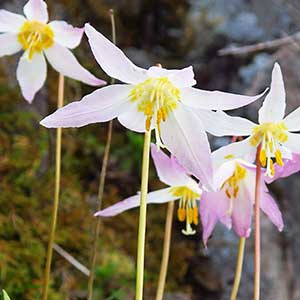Erythronium elegans
Erythronium californicum
Coast Range fawn lily, elegant fawn-lily
California fawn-lily
slender, 30–50 mm.
ovoid, 35–60 mm, sometimes producing sessile offsets.
7–20 cm;
blade green or faintly mottled with brown or white, narrowly ovate, margins often wavy.
7–18 cm;
blade distinctly mottled with irregular streaks of brown or white, oblong to narrowly ovate, margins usually wavy.
10–30 cm.
± reddish, branched well above leaves when flowers more than 1, 10–30 cm.
1–2(–4)-flowered.
1–3-flowered.
tepals: inner ± white, outer ± white and tinged (often strongly) with pink, especially abaxially and along midline, becoming more generally pinkish with age, both inner and outer with yellow band at base, lanceolate to narrowly elliptic, 20–40 mm, abaxial surfaces and outer tepals often darker, inner auriculate at base;
stamens 13–22 mm;
filaments white, flattened, slightly widened, linear to lanceolate, 0.8–2 mm wide;
anthers yellow;
style white, 10–20 mm;
stigma with slender, usually recurved lobes 2–4 mm.
flowering individuals generally abundant in populations;
tepals white to cream, base yellow and often banded with brown or red, ± narrowly ovate, 25–40 mm, inner with small auricles at base;
stamens 12–25 mm;
filaments ± white, linear, slender, less than 0.8 mm wide;
anthers white to cream;
style ± white, 10–14 mm;
stigma unlobed or with lobes less than 2 mm.
obovoid to oblong, 2–5 cm.
obovoid, 3–6 cm.
= 48.
= 24.
Erythronium elegans
Erythronium californicum
Of conservation concern.
This species is endemic to the Coast Ranges of western Oregon.
(Discussion copyrighted by Flora of North America; reprinted with permission.)
Forms intermediate with Erythronium citrinum and E. multiscapideum are sometimes seen where ranges overlap.
(Discussion copyrighted by Flora of North America; reprinted with permission.)


